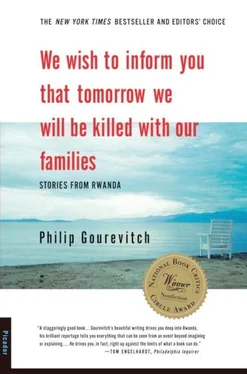The killers killed all day at Nyarubuye. At night they cut the Achilles tendons of survivors and went off to feast behind the church, roasting cattle looted from their victims in big fires, and drinking beer. (Bottled beer, banana beer—Rwandans may not drink more beer than other Africans, but they drink prodigious quantities of it around the clock.) And, in the morning, still drunk after whatever sleep they could find beneath the cries of their prey, the killers at Nyarubuye went back and killed again. Day after day, minute to minute, Tutsi by Tutsi: all across Rwanda, they worked like that. “It was a process,” Sergeant Francis said. I can see that it happened, I can be told how, and after nearly three years of looking around Rwanda and listening to Rwandans, I can tell you how, and I will. But the horror of it—the idiocy, the waste, the sheer wrongness—remains uncircumscribable.
Like Leontius, the young Athenian in Plato, I presume that you are reading this because you desire a closer look, and that you, too, are properly disturbed by your curiosity. Perhaps, in examining this extremity with me, you hope for some understanding, some insight, some flicker of self-knowledge—a moral, or a lesson, or a clue about how to behave in this world: some such information. I don’t discount the possibility, but when it comes to genocide, you already know right from wrong. The best reason I have come up with for looking closely into Rwanda’s stories is that ignoring them makes me even more uncomfortable about existence and my place in it. The horror, as horror, interests me only insofar as a precise memory of the offense is necessary to understand its legacy.
The dead at Nyarubuye were, I’m afraid, beautiful. There was no getting around it. The skeleton is a beautiful thing. The randomness of the fallen forms, the strange tranquillity of their rude exposure, the skull here, the arm bent in some uninterpretable gesture there—these things were beautiful, and their beauty only added to the affront of the place. I couldn’t settle on any meaningful response: revulsion, alarm, sorrow, grief, shame, incomprehension, sure, but nothing truly meaningful. I just looked, and I took photographs, because I wondered whether I could really see what I was seeing while I saw it, and I wanted also an excuse to look a bit more closely.
We went on through the first room and out the far side. There was another room and another and another and another. They were all full of bodies, and more bodies were scattered in the grass, and there were stray skulls in the grass, which was thick and wonderfully green. Standing outside, I heard a crunch. The old Canadian colonel stumbled in front of me, and I saw, though he did not notice, that his foot had rolled on a skull and broken it. For the first time at Nyarubuye my feelings focused, and what I felt was a small but keen anger at this man. Then I heard another crunch, and felt a vibration underfoot. I had stepped on one, too.
RWANDA IS SPECTACULAR to behold. Throughout its center, a winding succession of steep, tightly terraced slopes radiates out from small roadside settlements and solitary compounds. Gashes of red clay and black loam mark fresh hoe work; eucalyptus trees flash silver against brilliant green tea plantations; banana trees are everywhere. On the theme of hills, Rwanda produces countless variations: jagged rain forests, round-shouldered buttes, undulating moors, broad swells of savanna, volcanic peaks sharp as filed teeth. During the rainy season, the clouds are huge and low and fast, mists cling in highland hollows, lightning flickers through the nights, and by day the land is lustrous. After the rains, the skies lift, the terrain takes on a ragged look beneath the flat unvarying haze of the dry season, and in the savannas of the Akagera Park wildfire blackens the hills.
One day, when I was returning to Kigali from the south, the car mounted a rise between two winding valleys, the windshield filled with purple-bellied clouds, and I asked Joseph, the man who was giving me a ride, whether Rwandans realize what a beautiful country they have. “Beautiful?” he said. “You think so? After the things that happened here? The people aren’t good. If the people were good, the country might be OK.” Joseph told me that his brother and sister had been killed, and he made a soft hissing click with his tongue against his teeth. “The country is empty,” he said. “Empty!”
It was not just the dead who were missing. The genocide had been brought to a halt by the Rwandese Patriotic Front, a rebel army led by Tutsi refugees from past persecutions, and as the RPF advanced through the country in the summer of 1994, some two million Hutus had fled into exile at the behest of the same leaders who had urged them to kill. Yet except in some rural areas in the south, where the desertion of Hutus had left nothing but bush to reclaim the fields around crumbling adobe houses, I, as a newcomer, could not see the emptiness that blinded Joseph to Rwanda’s beauty. Yes, there were grenade-flattened buildings, burnt homesteads, shot-up facades, and mortar-pitted roads. But these were the ravages of war, not of genocide, and by the summer of 1995, most of the dead had been buried. Fifteen months earlier, Rwanda had been the most densely populated country in Africa. Now the work of the killers looked just as they had intended: invisible.
From time to time, mass graves were discovered and excavated, and the remains would be transferred to new, properly consecrated mass graves. Yet even the occasionally exposed bones, the conspicuous number of amputees and people with deforming scars, and the superabundance of packed orphanages could not be taken as evidence that what had happened to Rwanda was an attempt to eliminate a people. There were only people’s stories.
“Every survivor wonders why he is alive,” Abbé Modeste, a priest at the cathedral in Butare, Rwanda’s second-largest city, told me. Abbé Modeste had hidden for weeks in his sacristy, eating communion wafers, before moving under the desk in his study, and finally into the rafters at the home of some neighboring nuns. The obvious explanation of his survival was that the RPF had come to the rescue. But the RPF didn’t reach Butare till early July, and roughly seventy-five percent of the Tutsis in Rwanda had been killed by early May. In this regard, at least, the genocide had been entirely successful: to those who were targeted, it was not death but life that seemed an accident of fate.
“I had eighteen people killed at my house,” said Etienne Niyonzima, a former businessman who had become a deputy in the National Assembly. “Everything was totally destroyed—a place of fifty-five meters by fifty meters. In my neighborhood they killed six hundred and forty-seven people. They tortured them, too. You had to see how they killed them. They had the number of everyone’s house, and they went through with red paint and marked the homes of all the Tutsis and of the Hutu moderates. My wife was at a friend’s, shot with two bullets. She is still alive, only”—he fell quiet for a moment—“she has no arms. The others with her were killed. The militia left her for dead. Her whole family of sixty-five in Gitarama were killed.” Niyonzima was in hiding at the time. Only after he had been separated from his wife for three months did he learn that she and four of their children had survived. “Well,” he said, “one son was cut in the head with a machete. I don’t know where he went.” His voice weakened, and caught. “He disappeared.” Niyonzima clicked his tongue, and said, “But the others are still alive. Quite honestly, I don’t understand at all how I was saved.”
Laurent Nkongoli attributed his survival to “Providence, and also good neighbors, an old woman who said, ‘Run away, we don’t want to see your corpse.’” Nkongoli, a lawyer, who had become the vice president of the National Assembly after the genocide, was a robust man, with a taste for double-breasted suit jackets and lively ties, and he moved, as he spoke, with a brisk determination. But before taking his neighbor’s advice, and fleeing Kigali in late April of 1994, he said, “I had accepted death. At a certain moment this happens. One hopes not to die cruelly, but one expects to die anyway. Not death by machete, one hopes, but with a bullet. If you were willing to pay for it, you could often ask for a bullet. Death was more or less normal, a resignation. You lose the will to fight. There were four thousand Tutsis killed here at Kacyiru”—a neighborhood of Kigali. “The soldiers brought them here, and told them to sit down because they were going to throw grenades. And they sat.
Читать дальше











